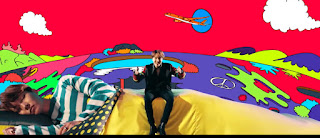Six years ago in my review of Tim Burton’s “Alice in Wonderland”, I said
that the only scenes that worked, where the ones where Burton was true to the
book. The same can be said about “Alice Through the Looking Glass”, but unfortunately
there is hardly any scenes that are true to Lewis Carroll’s book and besides,
the film isn’t even directed by Tim Burton.
“Alice Through the Looking Glass” is directed
by James Bobin, who is mostly known for directing TV-series and Muppets movies,
and the screenplay is written by Linda Woolverton, who is behind a long string
of Disney screenplays. I don’t know which of them messed it all up, but
somebody sure did, as Carroll’s highly interesting sequel to “Alice in
Wonderland” has been turned into a rather ordinary story.
There is no chess game to be played, no white knight or Queen Alice and
worst of all there is no slighty toves or borogoves or mome raths that outgrabe
in “Alice Through the Looking Glass”. Instead we have a grown Alice who is to
travel through time to save the Mad Hatter’s family. Yes, his family!
In this film,
everybody has been equipped with a background that explains how they have come
to be what they are or rather, why the Hatter is mad and why the Red Queen is
evil and has a big head. These explanations go against the inner logic in the
book where the Hatter is mad, because he is a Hatter and the Red Queen isn’t
evil at all as she is not the same as the Queen of Hearts from “Alice in Wonderland”!
Although “Alice Through the Looking Glass” wants to tie up all the loose
ends neatly, it raises more questions than it answers. Why are the Red Queen’s
servants made to look like the paintings of the 16th Century Italian artist
Guiseppe Acchimboldo, for instance, who used to paint human heads made up by
vegetables, fruit, flowers, fish and books?
Why is Time in
love with the Red Queen? We know what she wants with him, but what does he want
with her?
Why does Time
speak with a German accent?
And why is Time both
a person and an ocean? In one scene he is depicted as a person, but in the next
time is an ocean and the person Time is even travelling through the ocean Time.
It doesn’t make sense, not even in illogical Wonderland.
The characters in “Alice Through the Looking Glass” are played by the
usual gang with Mia Wasikowska as Alice, Johnny Depp as the Mad Hatter, Helena
Bonham Carter as the Red Queen and Anne Hathaway as the White Queen and as a
newcomer to the ensemble we see Sascha Baron Cohen as the personified Time.
There are no great
performances to praise, though, as there is nothing for the actors to work
with. The main characters are all reduced to gestures like the White Queen’s
hand movement or ways of talking like Time’s strong, German accent, so one has
to look to the supporting roles to be entertained.
I laughed out loud
when Andrew Scott was introduced as Dr. Addison Bennett who is to cure Alice
for female hysteria and I shed a tear as Alan Rickman repeated his role as the
caterpillar that had turned into a blue butterfly. It was very strange hearing
his characteristic voice four months after his death and I was reminded what a
brilliant actor we have lost.
“Alice Through the Looking Glass” reminds me of both “Time Bandits”
(1981) and “The Time Machine” (1960), but it is not as good as any of them,
mainly because it is very superficial and has nothing to do with Lewis
Carroll’s universe. There is more to it than that, though, and I think it has
to do with Americans filming the European literary heritage.
Although the US is
a leading nation when it comes to movie-making, it has never understood Europe’s
fairy tales and children’s stories. Where the European stories are mostly dark,
mysterious, strange and often unexplainable, the US movie makers turn them into
colourful, fun, feel-good stories. Just look at the disastrous screen versions
of Pippi Longstocking (“The New Adventures of Pippi Longstocking”, 1988), Peter
Pan (“Hook”, 1991) and Disney’s animated Hans Christian Andersen remakes.
Only one scene really works in Bobin’s Alice-film and that is the one
with the Mad Hatter, the March Hare, the Dormouse and the Cheshire Cat cracking
bad time-jokes. It is by the way also the only scene that is true to, not “Through
the Looking Glass”, but “Alice in Wonderland” although in the book, Time traps
the Mad Hatter and his friends in a perpetual teatime, because the Queen of
Hearts said the Mad Hatter was “murdering time” while he performed a song
badly. In any case, it is much too little to justify a 113 minutes long feature
film in 3D, 2D or whichever D!
“Alice Through the
Looking Glass” is one in a long line of sequels that should never have been
made. I can only give it two out of five stars, one for the hilarious
time-jokes at the tea party and one for the supporting cast: **


